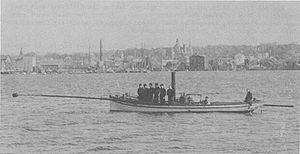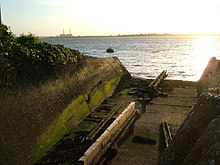Torpedo
A modern torpedo is a self-propelled projectile that travels underwater and is designed to detonate in proximity to or on contact with a target. It was used in most conflicts of the 20th century.
First torpedoes
In the XIX century, any marine explosive device intended to sink a ship was called a torpedo; they were static explosive charges. Currently, these are the marine mines and were widely used after the Civil War. The application of torpedoes encouraged the development of a new type of light vessel for their use, being known as torpedo boats.
Pan Torpedo
Also called spar torpedo or boom torpedo, it was a torpedo used in warships, mainly launches or boats such as the Castor and Pollux of the Spanish Navy, although it was also installed on some ships, such as Casco Class monitors.
It consisted of a pole or long boom placed at the bow of the boat, having an explosive charge (torpedo) at the end. Its use consisted of hitting the enemy ship with the pole and the torpedo was detonated by electricity, fire or an impact fuze. The first successful use of the boom torpedo was in the sinking of the armored CSS Albemarle during the Civil War.
The danger was that the explosion could be so strong that it could even sink the very ship carrying the torpedo.
It had very little practical application, because to sink enemy ships they had to get very close to them and when discovered, the enemy ship could flee or avoid it. One successful application was the sinking of the Turkish monitor Seyfi during the Russo-Turkish War (1877-1878). This unmaneuverable and slow ship could not avoid the joint attack of the Russian torpedo boats.
The most popular system was the McEvoy electrically fired torpedo.
Harvey Torpedo
They were also known as trailer torpedoes or trailer. The first country to adopt it was Russia in 1869 and then England the following year. In the 1870s, a class of torpedo boats carrying an explosive charge in tow arose in the United Kingdom, the best known being the Harvey system. The boats had a long cable that towed the torpedo, and built in such a way to deviate, diverge from the course of the boat that towed it when approaching the enemy ship, the torpedo boat turned away, thus allowing the towed torpedo in an asymmetrical way. with respect to the course followed by the boat, and with a somewhat long towing cable, it will crash against the white ship. It never had a successful application.
From January 1880 it began to be removed from British warships.
All these types of torpedoes fell into disuse when mobile torpedoes were widely used.
Mobile Torpedoes
Torpedoes as we know them now, were called mobile torpedoes or fish, because of their fish-like appearance, they began to be used in the 1860s. At that time the following were developed:
Brennan Torpedo
It was invented by Brennan, a scientist from Melbourne.
It was 6 m long and half a meter in diameter. It was heading from the boat from which it had been launched thanks to a cable. It had a range of 1800 meters. Its patent was bought by the United Kingdom in 1882, because it was a British version of the Torpedo Lay used by the United States, but it never had a practical application due to its difficult direction control in the water.
Howell Torpedo
Designed by Rear Admiral J. A. Howell, its development began in 1870 and was completed in 1889. It was the first successful mobile torpedo in the United States, as it had a pendulum that guided the course of the torpedo so that it had good direction on the surface.
It was scrapped when the United States adopted the Whitehead Torpedo in 1898.
Torpedo Lay
Invented by American military engineer John Louis Lay, creator of several torpedoes in the Civil War. One of his boom and cable torpedo designs sank the armored CSS Albermale, in 1864.
It was 7.6 m long and 600 mm in diameter and was propelled by pressurized carbon dioxide and directed by two electrical cables from the vessel or station from which it was launched. And with an effective range of 2,000 m, a speed of 11 km/h, a load of 45 kg of dynamite and a total weight of 1,270 kg. It was adopted by the United States Navy, reluctant to purchase and use Whitehead torpedoes, in 1872.
In 1879 during the War of the Pacific, Peru purchased at least five Lay self-propelled torpedoes and several sparge torpedo systems.
In the early morning of August 25, 1879 in Antofagasta, the Peruvian monitor Huáscar, under the command of Captain Miguel Grau Seminario, stealthily entered the port and saw the Chilean ships behind neutral ships Abtao, Magallanes, at a distance of 300 meters, the Huáscar launched a Lay self-propelled torpedo guided by cable against the Abtao but it reversed its course and to save the monitor an officer jumped overboard to divert it.
In 1880, the so-called Lay Haight torpedo came out, an improved version of the previous one, with a range of 2,300 meters, in which, to increase its speed to 8 knots, a mixture of carbonic acid and calcium was used.
Having passed initial tests, the US and Russian Empire governments purchased its manufacturing rights. Lay himself set up a manufacturing plant in Russia where the manufacture of more than 10 large torpedoes was reported. However, it never had a successful application and was only used by the United States and Peru during the Pacific War.
Schwartzkopff Torpedo
In 1873, the firm of L. Schwartzkopff, later known as Berliner Maschineubau A. G., began manufacturing torpedoes based on the Whitehead Torpedo design. Its characteristics were:
- Long, 4.5 m; diameter, 35 cm; speed, 43-45 km/h for 200 m, 40-42 km/h for 400 m; weight, 280 kg; air pressure, 10'3 MPa; explosive charge, 20 kg.
Schwartzkopff was authorized to sell to countries approved by Germany: Russia, Japan and Spain. The advantage of it over the Whitehead Torpedoes was the resistance to corrosion, since they were made of brass.
Its first successful application was when two longboats sank the Brazilian rebel battleship Javary in 1893 during the bombardment of Rio de Janeiro.
Whitehead Torpedo
The Whitehead torpedo is the ancestor of the torpedoes we know today.
In the mid-19th century, an Austrian officer conceived the idea of using a boat, loaded with steam-propelled explosives or air pressure and directed by cables against enemy ships. After his death and before his invention was made public, the anonymous work came into the hands of Captain Giovanni Luppis of the Austro-Hungarian Navy. Luppis had designed a mechanically driven boat steered by cables. In 1864, Luppis commissioned the work to Robert Whitehead, an English engineer who was then manager of the Stabilimento Técnico Fiumano, a factory in Fiume, Austro-Hungarian Empire (now Rijeka, Croatia). Whitehead was impressed by the potential of such a weapon and was determined to design and build a torpedo capable of traveling a reasonable distance underwater.
In October 1866 the first model was ready, whose construction patent was sold to Austria in 1867. This model, made of steel, had a speed of 11 to 22 km/h for a distance of 183 m, propelled by compressed air at a pressure of 2400 kPa. In parallel, the Russian inventor I. F. Aleksandrovskiy had also designed a mobile air-propelled torpedo, but Russia preferred the Whitehead model.
Whitehead further developed his invention and offered two more models in 1868:
- Long, 11 feet 7 inches; diameter, 14 inches; weight, 346 pounds; explosive charge, 40 pounds.
- Long, 14 feet; diameter, 16 inches; weight, 650 pounds; explosive charge, 60 pounds.
In both, speed was 8-10 knots and range 200 yards. The price was £150 for the small and £250 for the large model.
By 1877, Whitehead had developed models with speeds of 18 knots for a range of 830 yards and 22 knots for a range of 200 yards, with an air pressure of 1,100 psi.
The UK bought Whitehead torpedoes in 1870 and bought the manufacturing rights the following year. France, Germany, Italy and Russia were the next countries to buy these torpedoes, being Chile in 1877 and Argentina in 1878, the first to buy it in America. Whitehead offered the United States government the sale of his patent in 1869 for $75,000 and then in 1873 for $40,000, turning them down both times because he was more confident in the torpedoes he was developing within the country, although in 1892 it was finally agreed. an agreement to manufacture one hundred Whitehead Mk 1 torpedoes at a price of $2,000 each.
Whitehead confessed to selling 1,500 torpedoes by 1880 to the following countries: United Kingdom, 254; Russia, 250; France, 218; Germany, 203; Austria, 100; Denmark, 83; Greece, 70; Italy, 70; Portugal, 50; Argentina, 40; Belgium, 40; Chile, 26; Norway, 26 and Sweden, 26.
The first use of this torpedo in combat was in 1877 by the British Royal Navy against the Peruvian monitor Huáscar, during the combat of Pacocha, which had been captured by rebels against the Peruvian government, being the first ship in history to dodge a self-propelled torpedo. The following year, during the Russo-Turkish war, two launches torpedoed the Turkish steamer Intibakh, but the first successful attack on an armored war unit was during the Chilean civil war of 1891, when it was The armored frigate Blanco Encalada of the congressional forces was sunk in the port of Caldera by the torpedo hunter Admiral Lynch who served on the Balmacedista side. Curiously, the Huáscar, already under the Chilean flag, was also present at that action.
Type 93 Torpedo
The most lethal torpedoes of World War II were the Japanese Type 93, with a diameter of 610 mm, capable of ripping a destroyer of the time in two. It turned out to be one of the most effective during the war, it had a load of 450 kg of TNT and a range of about 32 km, it was also the fastest of all: it could reach 65 knots at 2.5 m depth.
By using pure oxygen instead of compressed air, it distinguished itself by not leaving a trail of bubbles of unburned gases, mainly nitrogen, in its path.
Coastal Defense Aerial Torpedo Tube
The coastal defense aerial torpedo launch tube was in use during World War II, mainly to defend the straits or certain islands. Among his achievements, the best known episode is the case of the German ship Blücher (1939) sunk on April 9, 1940 during the Battle of Drøbak Strait in Norway.
Their use is now partially obsolete following the widespread use of anti-ship missiles, including those for coastal defense. However, its use is still relevant in the coastal defense of islands or straits. In recent technology, torpedo maker DM2A4 has also developed a mobile (trailer) torpedo launcher for it, then it is fitted with a guidance mast/antenna because it is normally guided by wire.
Current Torpedoes
A modern torpedo, like the Mark-48, contains the equivalent of 550 kg of TNT. This explosive maximizes its effect when the device explodes under the target's keel, instead of hitting it from the side. When detonation occurs below the keel, the resulting pressure wave lifts the ship, and may break its keel in the process. When the ship descends again, it receives new destructive effects as the explosion itself breaks through the previously damaged area. The combined destroyer effect tends to split small targets in half, and severely damage larger displacement ships. As an example, the Torrens destroyer in the image was displacing 2700 t.
Contenido relacionado
IBM S/360
Triac
Iberia (airline)





